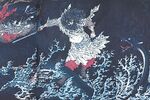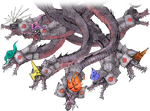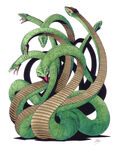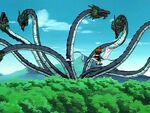Yamata no Orochi (Japanese: 八岐大蛇 OR やまたのおろち), or just Orochi, is a famous eight-headed and eight-tailed serpent in Japanese mythology known to enjoy alcohol and human flesh.
Appearance[]
Yamata no Orochi is a gigantic serpent with eight heads and eight tails. It has bright red eyes and a red belly. The beast is so large that its body covers the distance of eight valleys and eight hills. Fir and cypress trees grow on its back, and its body is covered in moss.
Origin[]
Yamata no Orochi appears in the earliest written Japanese documents, the Kojiki and the Nihongi. The legend goes back even farther into pre-history.
Battle with Susanoo[]
Ages ago, the storm god, Susano-o, was thrown out of heaven and descended to earth at Mount Torikama near the Hi River in Izumo Province. There, he came upon an elderly couple of gods named Ashinazuchi and Tenazuchi, who were weeping. When Susanoo asked why they were crying, they explained that they once had eight daughters, but every year the eight-headed-eight-tailed serpent Yamata no Orochi demanded one as a sacrifice. They were now down to their eighth and final daughter, Kushinada-hime. Soon it would be time for Yamata no Orochi to demand a sacrifice.
Susanoo explained that he was the elder brother of the sun goddess Amaterasu, and offered to slay the beast in return for Kushinada hime’s hand in marriage. The elderly couple agreed, and Susanoo set in motion his plan to defeat the serpent.
First, Susanoo transformed Kushinada hime into a comb, which he placed in his hair. Then, he had Ashinazuchi and Tenazuchi build a large fence with eight gates. On each gate they raised a platform and on each platform they placed a vat. They poured extremely strong sake into each vat. When this was finished, everyone waited for the serpent to arrive.
When Yamata no Orochi appeared, the great serpent slithered into the fence and noticed the powerful sake. It dipped its eight heads into the vats and drank the alcohol. Soon, the monster fell into a deep, drunken sleep. Susanoo used this chance to make his attack. He sliced the enormous beast into tiny pieces with his sword. The carnage was so great that the Hi River flowed with blood. When Susanoo had cut the creature down to its fourth tail, his sword shattered into pieces. Examining the part of Yamata no Orochi’s tail which broke his sword, Susanoo discovered another sword within the creature’s flesh: the legendary katana, Ame-no-Murakumo-no-Tsurugi ("Sword of the Gathering Clouds of Heaven"), which was later offered to Amaterasu as a reconciliation gift.
In Popular Culture[]
Television & Movies[]
- Orochi made an appearance in the film The Three Treasures (1959) as a kaiju.
- Orochi also made an appearance in another Toho film called, "Orochi, The Eight-Headed Dragon (1994)."
- In Naruto, an opponent name Orochimaru can take on the form of a white Orochi.
- In One Piece, the shogun of Wano, Kurozumi Orochi, ate hebi hebi no mi model: Yamata no Orochi, which allows the user to transform into the eight-headed serpent.
- Orochi was used as inspiration for the creation of King Ghidorah, a three-headed dragon that serves as Godzilla's archenemy in the Godzilla franchise.
- In Godzilla, Mothra and King Ghidorah: Giant Monsters All-Out Attack, King Ghidorah is said to be Yamata no Orochi, with only 3 of his 8 heads grown back.
- In Godzilla: King of the Monsters, there is a Titan named after Orochi. Security footage of Orochi escaping its outpost was shown on a monitor.
Video Games[]
- In For Honor, the Orochi are Imperial assassins and a playable character.
- Orochi appears as a final boss in The King of Fighters '97.
- It is also one of the main bosses fought in Okami.
- In the Shin Megami Tensei series, Orochi is a recurring monster/Persona
- Orochi makes a human-like appearance in the card game Otogi: Spirit Agents
- In Nioh, Yamata no Orochi shows up as a boss to be fought.
Gallery[]
References[]
- http://www.japanesemythology.jp/yamata-no-orochi/
- http://www.ancient-mythology.com/japanese/orochi.php
| Japanese mythology | |
|---|---|
| Mythic Texts | Kojiki • Nihon Shoki |
| Japanese Creation Myth | Kotoamatsukami • Kamiyonanayo • Kuniumi • Kamiumi • Izanagi-no-Mikoto • Izanami-no-Mikoto • Kagutsuchi • Watatsumi |
| Takamagahara Mythology | Amaterasu • Susano-o • Tsukuyomi • Ame-no-Uzume |
| Izumo Mythology | Yamato no Orochi • Hare of Inaba • Ōkuninushi |
| Hyuga Mythology | Tenson korin • Ninigi • Konohanasakuya-hime • Hoderi • Hoori • Toyotama-hime • Ugayafukiaezu |
| Human Age | Emperor Jimmu • Kesshi Hachidai |
| Mystical Locations | Ryugu-jo • Takamagahara • Amano-Iwato • Yomi • Ashihara no Nakatsukuni |
| Major Buddhist Figures | Amida Nyorai • Daruma • Five Wisdoms Buddhas • Akuma/Mara |
| Seven Lucky Deities | Benzaiten • Bishamonten • Daikokuten • Ebisu • Fukurokuju • Hotei • Jurojin • Kichijoten |














